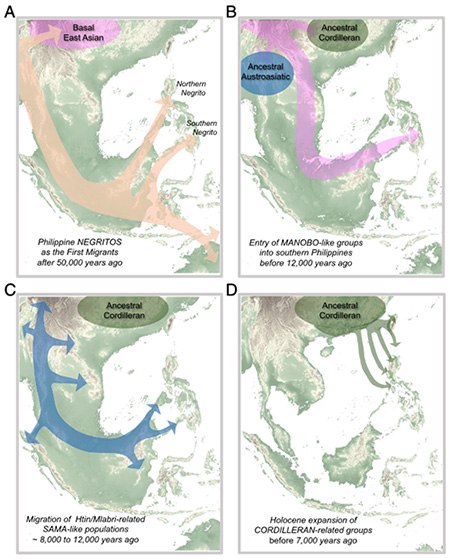A landmark study has revealed the complex shared origins, inter-relatedness, and genetic diversity of the Filipino people

“This finally gives us a clearer picture of who we are as Filipinos, where we came from, our sense of relatedness”, says co-author Carlo Ebeo, Board of Trustee member of the National Museum.
The study revealed that, through time, the Philippines was inhabited by at least five major waves of human migrations: starting with Northern and Southern Negritos as the first Filipinos, followed by Manobo, Sama, and Cordilleran-related populations.
The last three major waves happened around 7–15 thousand years ago, coinciding with the major geographic changes in the region that were brought about by climate change. These include the inundation of the Sunda landmass and the loss land bridge between Taiwan and southern China.
It was previously thought that the search for new arable lands by expanding farmer populations was the main reason for causing population migrations, such as the dispersal of Austronesian-speaking groups into the Philippines.
However, Dr Maximilian Larena, a Filipino scientist based in Sweden who co-led the study, challenges this view and says “Our findings suggest that instead of farming, climate change may have played a more important role in driving the mass movement of populations in various directions”.
The European genetic signal was only detected in ~1% of all individuals investigated, indicating a limited genetic legacy of the Spanish Colonial Period.
The study was made possible through the partnership between Uppsala University of Sweden led by Professor Mattias Jakobsson and Dr Maximilian Larena, and the National Commission for Culture and the Arts of the Philippines through the office of then chairperson Felipe Mendoza de Leon.
“This is a groundbreaking study that the commission fully supported, and we should be thankful for this collaboration as it shed some light on the long-standing question of our origins”, says Prof Felipe Mendoza de Leon.
Aside from the extensive network of cultural workers provided by the National Commission for Culture and the Arts of the Philippines, the scientific endeavour involved collaboration with indigenous cultural communities, local universities, local government units, non-governmental organizations, and regional offices of the National Commission for Indigenous Peoples.
More importantly, the study is one of its kind in terms of the active involvement of the Indigenous Peoples. Some are co-authors of the study, in recognition of their essential contribution, indigenous knowledge, ownership and shared responsibility of the work.
Reference
Larena M, Sanchez-Quinto F, Sjödin P, McKenna J, Ebeo C, Reyes R, Casel O, Huang J-Y, Hagada KP, Guilay D, Reyes J, Allian FP, Mori V, Azarcon LS, Manera A, Terando C, Jamero Jr L, Sireg G, Manginsay-Tremedal R, Labos MS, Vilar RD, Latiph A, Saway RL, Marte E, Magbanua P, Morales A, Java I, Reveche R, Barrios B, Burton E, Salon JC, Kels MJT, Albano A, Cruz-Angeles RB, Molanida E, Granehäll L, Vicente M, Edlund H, Loo J-H, Trejaut J, Ho SYW, Reid L, Malmström H, Schlebusch C, Lambeck K, Endicott P, Jakobsson M. 2021. Multiple migrations to the Philippines during the last 50,000 years. Proceedings of the National Academy of Sciences of the USA 118, e2026132118.